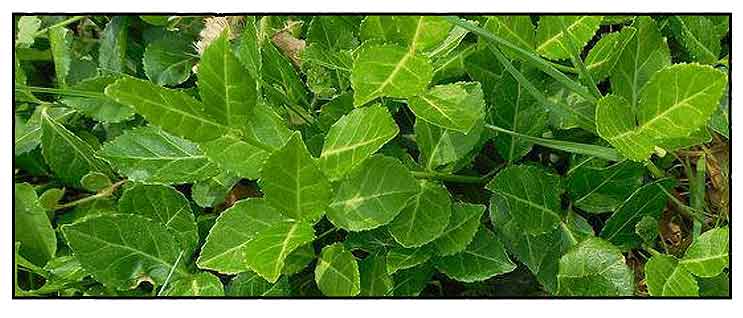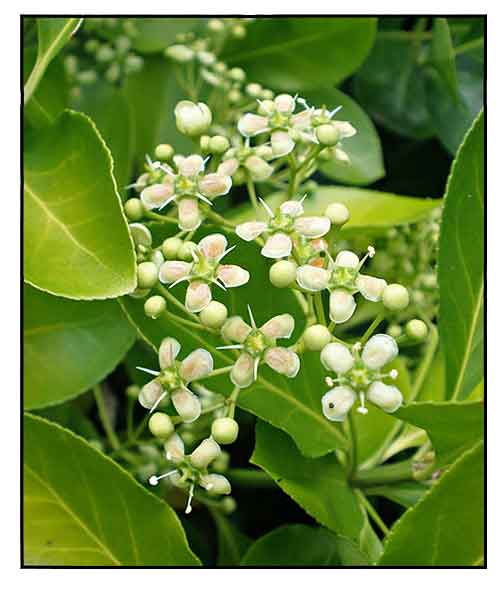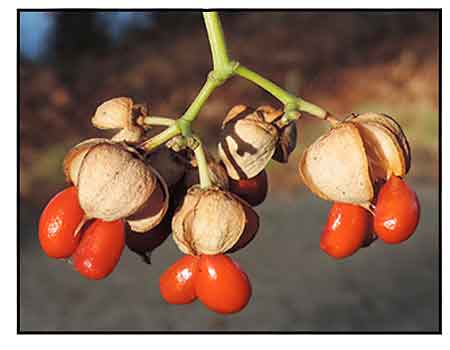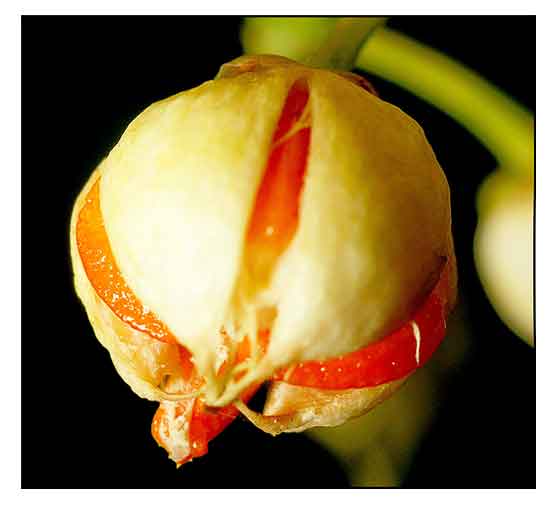 Gen info Gen info
- Euonymus comprises about 180 species, most occurring in the Himalayas, China, and Japan. Europe has 4 species, Africa 1, Madagascar 2, North and Central America 9, Australia 2, and Malesia 12. (2)
- Wildly cultivated as an ornamental plant. Some cultivars have been given the Royal Horticultural Society's Award of Garden Merit.
(3)
- Euonymous fortunei is the most common and widespread species in the genus.
- The plant is often confused with Euonymus japonicus, Ficus pumila, Gelsemium sempervirens, Lonicera japonica, Vinca major, Vinca minor. (10)
-
Taxonomy / Etymology: It was first described in 1863 as Elaeodendron fortunei by Nikolai Turczaninow, who named it in honor of the Scottish botanist and plant explorer Robert Fortune. It was transferred to the genus Euonymus in 1933 by Heinrich von Handel-Mazzetti. (3) The genus name Euonymus derives from Greek, meaning "well-named" or "lucky" -- a euphemistic reference to its fruits (species form), which are toxic to animals. (4)
- E. fortunei is widely cultivated as an ornamental plant, with numerous cultivars. The following cultivars have gained the Royal Horticultural Society's Award of Garden Merit: Emerald Gaiety, Emerald 'n' Gold, Emerald Surprise, Kewensis, and Wolong Ghost. (3)
 Botany Botany
• Euonymus fortunei is an evergreen shrub which grows as a vine if provided with support. As such it grows to 20 m (66 ft), climbing by means of small rootlets on the stems, similar to ivy (an example of convergent evolution, as the two species are not related). Like ivy, it also has a sterile non-flowering juvenile climbing or creeping phase, which on reaching high enough into the crowns of trees to get more light, develops into an adult, flowering phase without climbing rootlets. Leaves are arranged in opposite pairs, elliptic to elliptic-ovate, 2–6 cm long and 1–3 cm broad, with finely serrated margins. Flowers are inconspicuous, 5 mm in diameter, with four small greenish-yellow petals. Fruit is a smooth, dehiscent capsule with reddish arils. (3)
• Evergreen subshrubs, ascending or procumbent on ground or rock, trees sometimes dwarfed, to 10 m tall; branches and twigs rounded, sometimes striate, usually brown or green-brown. Leaves densely arranged on branches; petiole 2-9 mm, sometimes sessile; leaf blade variously ovate or ovate-elliptic, 2-5.5 × 2-3.5 cm, glabrous, base nearly truncate, at times ± cuneate, margin crenulate to serrate, apex obtuse to acute; lateral veins 4-6 pairs, invisible. Peduncle usually with few flowers; pedicel usually less than ca. 5 mm. Flowers 4-merous, ca. 5 mm in diam.; sepals semirotund; petals nearly orbicular, greenish or whitish. Capsule brown to red-brown, 5-6 mm in diam. Aril red. (Flora of China)
Distribution
- Native to the Philippines.
- Also native to Assam, China, Hainan, Japan, Jawa, Korea, Laos, Lesser Sunda Is., Manchuria, Myanmar, Nansei-shoto, Qinghai, Sulawesi, Sumatera, Taiwan, Thailand, Vietnam, Xinjiang. (1)
- Widely cultivated as an ornamental plant.
- Considered an invasive species in some parts of the world, notably eastern United States and Canada, where it is reported to cause death of trees and forest in urban areas. (2)
 Constituents Constituents
- An ethyl acetate fraction yielded high total phenolic and total flavonoid contents with 707.2 mg gallic acid equivalents and 581 mg rutin equivalents /g extract, respectively. HP:C analysis of ethanol crude extract yielded large numbers of flavonoids and its glycosides. (see study below) (5)
- Study of aerial parts isolated a new flavonol glycoside, kaempferol-3-O-ß-D-(2-O-E-p-coumaroyl)-glucopyranosyl-7-O-α-I-rhamnopyranoside (1), along with 11 known compounds, including 5 flavonol glycosides (2-6), one phenolic glycosile (7), two megastigmane glycosides (8 and 9), two triterpenoids (10 and 11) and one alditol (12). (7)
Properties
- Studies have suggested antioxidant, hemostatic, anticancer, immunomodulatory, antiviral properties.
Toxicity concern
- There are no records of toxicity for this species of Euonymus. However, some plants in this genus are poisonous and caution is advised. It is advised to avoid eating any parts of the plant in large quantities. Although eaten by birds, the berries should not be eaten by humans. (10)
 Uses Uses
Edibility
- While eaten by birds, advice is that berries should not be eaten by humans. It is also advised to avoid eating any parts of the plant in large quantities.
Folkloric
- No reported folkloric medicinal use in the Philippines.
- In China, used as tea for enhancement of immunity and disease resistance. Used for anticancer properties.
Others
- Agroforesty: Used as ground-cover or vine to climb walls and trees.
Studies
• Antioxidant: Study evaluated ethanol crude extract and fractions for total phenolic and flavonoid contents, and antioxidant activity by DPPH and ABTS radical scavenging assays. The ethyl acetate fraction yielded high total phenolic and total flavonoid contents with 707.2 mg gallic acid equivalents and 581 mg rutin equivalents /g extract, respectively. The EA fraction also exhibited strongest activity with EC50 of 0.25 mg/mL, followed by n-butanol fraction. Results suggest a natural source of antioxidants and healthy tea. (see constituents above) (5)
• Hemostatic Activity / Aerial Parts: Study evaluated the hemostatic effect of ethanol extracts and different fractions of aerial parts and the changes in intracellular calcium ion concentration in platelet cells. The n-butanol fraction not only significantly shorten the bleeding time and coagulation time, but also shorted activated partial thromboplastin time (PTT). There was no effect on fibrinogen content. The excellent hemostatic activity may be related to the increase in intracellular Ca2+ concentration caused by G protein-coupled receptor on the platelet membrane surface. Results suggest potential use of the plant for hemostatic treatment. (6)
• Anticancer / Antioxidant / Polysaccharide: Study evaluated the extraction and biologic activity of fortunei polysaccharides (EFPs). A maximum yield of 2.63% was attained using material-liquid ratio of 60 mL/g, extraction temperature of 80°C, ultrasonic power of 144W, and extraction time of 75 mins. Monosaccharide composition of the EFPs included Gal, Glc, Man, Fuc, and Rha. The EFPs showed high antioxidant activity. The EFPs exhibited inhibition at concentration range of 200-800 µg/mL on SKOV3 cell proliferation. Flow cytometry confirmed the EFPs blocked cell cycle at G-0/G1 and S phases and induced SVOV3 cell apoptosis. (8)
• Antiviral: Study evaluated the in vitro antiviral activity and mechanism of action of an aqueous extract of EF (WEF) and its components. Pretreatment with WEF markedly reduced viral replication, using a green fluorescent protein (GFP)-tagged virus (influenza A virus, Newcastle disease virus, and vesicular stomatitis virus) in murine RAW 264.7 macrophage cells. WEF induced production of type I IFN including pro-inflammatory cytokines. Active anti-viral components of WEF identified were quercetin, psoralen, and quercitrin. Results suggest WEF and its components are immunomodulators of the innate immune response in murine macrophages, with potential for development of prophylactic or therapeutic treatments against a range of viruses. (9)
• Determination of Dulcitol and Astralaloside: Study reports on a HPLC-ELSD method for determining dulcitol and astragaloside in compoud Fufangteng capsules. The linear ranges of dulcitol and astragaloside were 2.91 µg and 1.03 µg, respectively. Average recoveries of dulcitol and astrogaloside were 99.24% and 103.17% with RSD of 2.6 and 1.8%, respectively. The method was stead and with good repeatability. (11)
Availability
Wild-crafted.
Ornamental cultivation.
|

![]()







